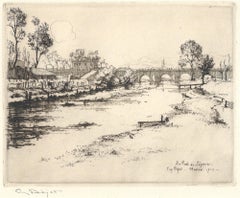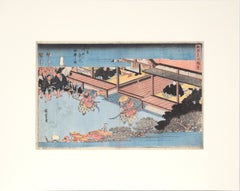Eugene Bejot Art
Eugène Béjot was a French etcher. He studied at the Académie Julian in Paris and learned to etch with Henri-Gabriel Ibels in 1891. Béjot's technical skills were already apparent in his 1892 first commissioned series, La Seine a Paris. He then firmly established his reputation with his widely acclaimed La Samaritaine, which was exhibited at the Peintres-Graveurs exhibition in Paris in 1893. Béjot’s work is inextricably linked to Paris. He made many etchings of the Seine, as well as of the quays and buildings of Paris. His delicate use of light evokes the city’s atmosphere. Béjot was very highly regarded in England. In 1908, he was elected to the Royal Society of Painter-Etchers and Engravers in London. He also became a Chevalier of the Legion of Honour in 1912.
Early 20th Century French School Eugene Bejot Art
Handmade Paper, Etching
1830s Edo Eugene Bejot Art
Ink, Rice Paper, Woodcut
1860s Edo Eugene Bejot Art
Ink, Rice Paper, Woodcut
1890s Edo Eugene Bejot Art
Rice Paper, Ink, Woodcut
Mid-20th Century French School Eugene Bejot Art
Metal
1890s Edo Eugene Bejot Art
Woodcut, Handmade Paper, Mulberry Paper
1880s Edo Eugene Bejot Art
Ink, Rice Paper, Woodcut
1820s Edo Eugene Bejot Art
Ink, Rice Paper, Woodcut
Early 19th Century Edo Eugene Bejot Art
Woodcut, Rice Paper, Ink
1890s Edo Eugene Bejot Art
Handmade Paper, Mulberry Paper, Woodcut
1890s Post-Impressionist Eugene Bejot Art
Lithograph, Mulberry Paper
Early 19th Century Edo Eugene Bejot Art
Woodcut, Rice Paper, Ink
21st Century and Contemporary Contemporary Eugene Bejot Art
Paper, Etching


